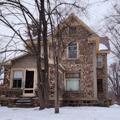In 1900, Harmon Palmer patented a cast-iron block-making machine, which Sears, Roebuck and Company sold by 1905. By changing the faceplate, the builder could create various surface textures. Johnson, a Swedish-born mason-contractor who erected many local buildings including Hudson’s city hall, did things differently. Here, instead of simulating a cobblestone texture, he placed real cobbles in the mold before adding the concrete. He then laid the colorful blocks like ashlar, with tooled mortar joints. This method also sets his house apart from southeastern Wisconsin’s nineteenth-century cobblestone houses in which stone buildings are veneered with cobblestones.
Johnson’s cross-gabled house combines exuberant irregularity and color with staid details, including cornice returns, stucco corner moldings, and flat lintels made of cobbles and concrete. More playful details include concrete blocks with diamond insets that enliven the gable ends and form a frieze beneath the eaves. The enclosed entrance porch on the south side, probably dating from the 1920s, blends with the original house, but there cobblestone rubble replaced cobblestone concrete block. The Johnson House also displays colorful glass decorations in the gable ends. Inside, the decorations change to wood. Carved entablatures top windows and doors, and the front hall staircase boasts oak newel posts carved with beads, sunflowers, and leaves.




















